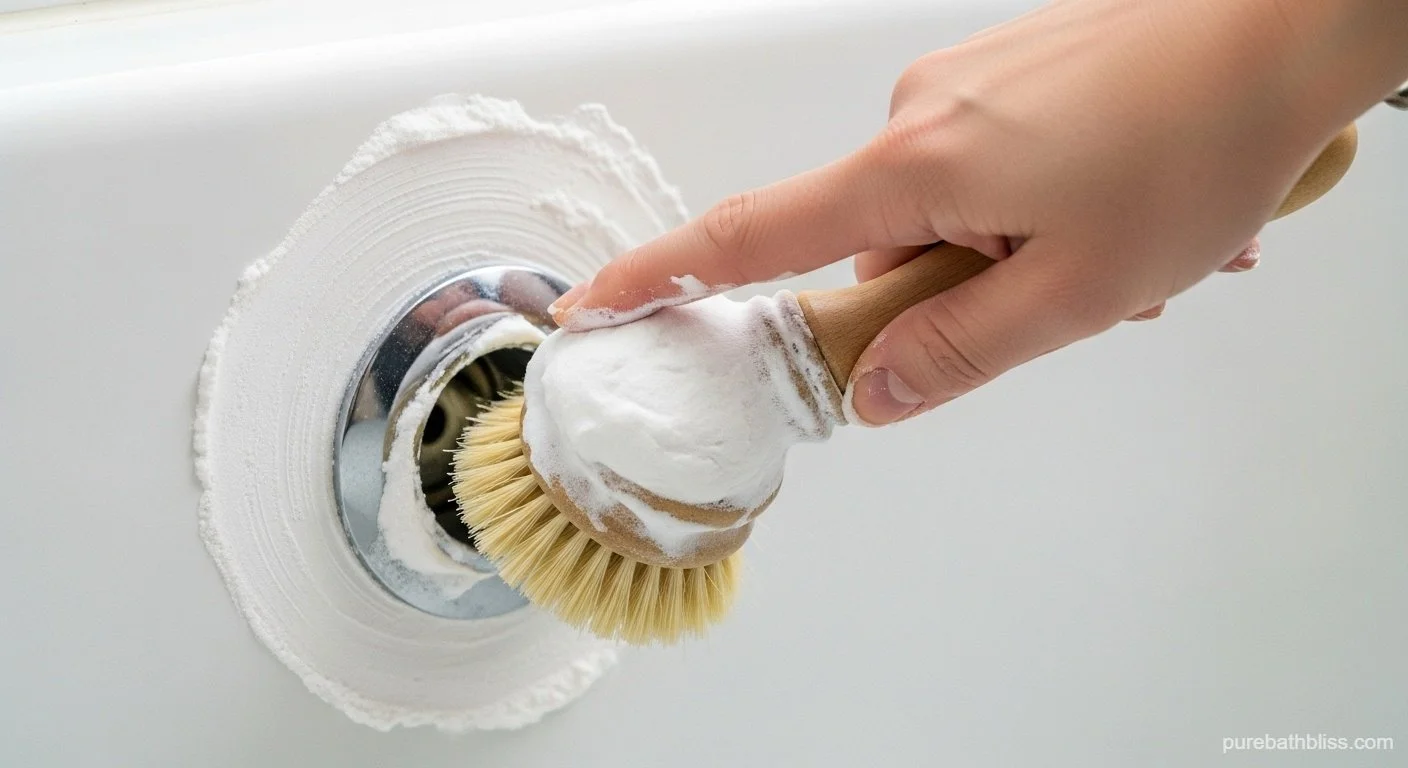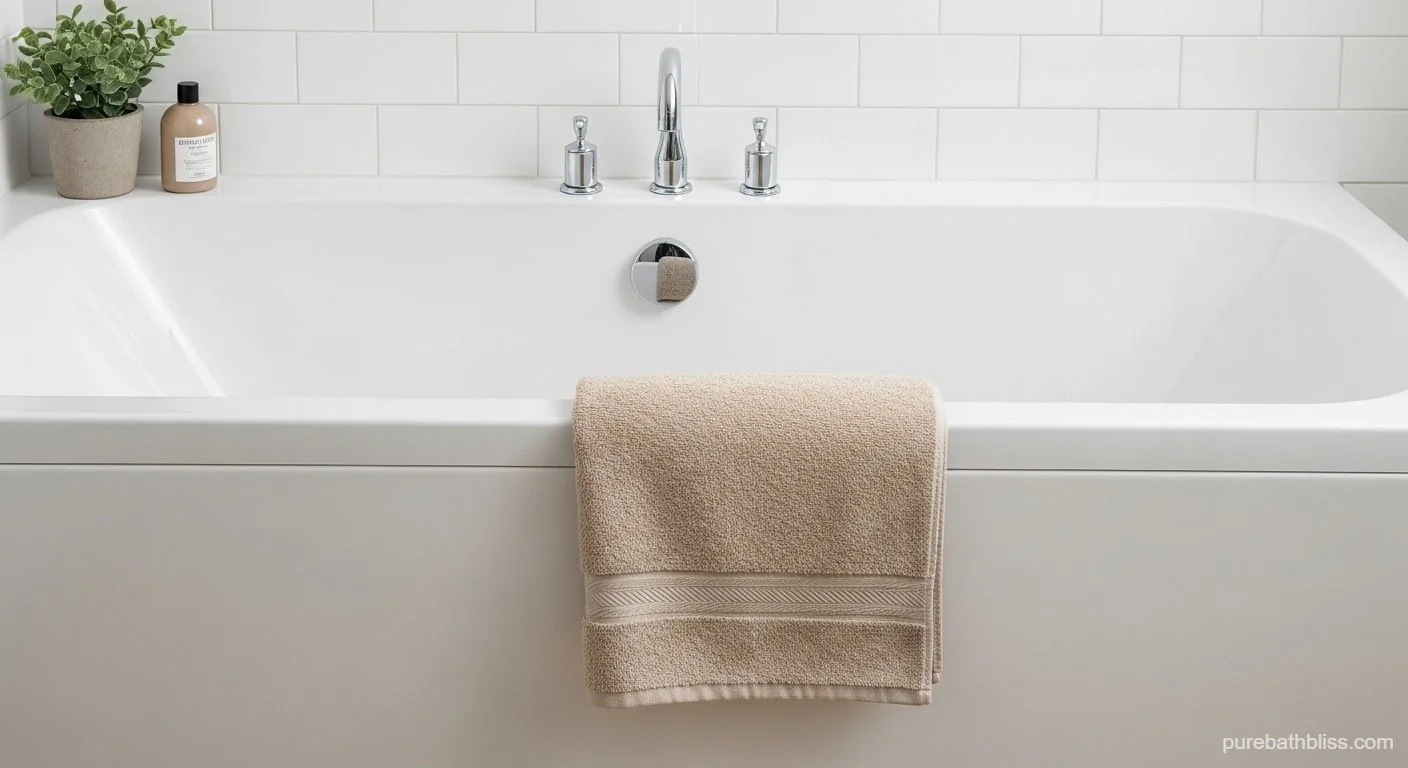Baby-Safe Cleaning: How to Scrub the Tub Without Harsh Chemicals
You want the tub sparkling clean for your baby. But the second you spray bleach, the sharp smell fills the bathroom and you think: “This can’t be safe for lungs that are still learning to breathe.”
You’re absolutely right.
Chemical cleaners leave invisible residue that warm bathwater can re-activate, and the fumes linger in a small, steamy room long after you’ve left. A truly baby-safe bathroom is cleaned with ingredients safe enough to eat—because, in a way, your baby will be “eating” whatever touches that tub.
This step-by-step guide gives you the exact non-toxic recipes and techniques that disinfect just as effectively—without a single warning label.
A clean tub is the foundation of the safe bathing routine outlined in our master guide: The Parent’s Guide to a Toxin-Free Tub: Ensuring Safety and Wellness for Your Baby.
The Hidden Hazard: Why Conventional Cleaners Are Unsafe
Chemical Residue That Never Really Leaves
Bleach, ammonia, and quaternary ammonium compounds (“quats”) bind to porcelain and plastic. Hot bathwater re-releases them as vapor or microscopic film. Result: your baby sits in a diluted soup of irritants that can trigger rashes, eczema flares, or respiratory discomfort.
Respiratory Risks in a Tiny Room
Volatile organic compounds (VOCs) from scented sprays and bleach linger for hours. A baby’s lungs are developing rapidly—exposure to these fumes has been linked to wheezing and higher rates of respiratory infections in the first year.
The “Antibacterial” Myth
Triclosan and similar agents were banned from soap by the FDA in 2016—yet they’re still in many tub cleaners. They’re unnecessary (plain soap + friction removes 99% of germs) and contribute to antibiotic resistance.
The Safe Cleaning Toolkit: 3 Essential Recipes
You only need three food-grade ingredients you probably already have.
1. The Daily Spray – Vinegar + Tea Tree
1 cup distilled white vinegar
1 cup filtered water
10–15 drops tea tree essential oil (Melaleuca alternifolia)
Optional: 5 drops lavender or lemon for scent
Why it works: Vinegar dissolves soap scum and mineral deposits. Tea tree is a broad-spectrum antimicrobial proven to kill mold, staph, and E. coli on contact.
2. The Deep Scrub – Baking Soda Paste
1 cup baking soda
1–2 tablespoons unscented liquid castile soap
Water to form a spreadable paste (like thick frosting)
Why it works: Gentle mechanical abrasion lifts grime without scratching porcelain or acrylic tubs.
3. The Mold Buster – 3% Hydrogen Peroxide
Straight food-grade 3% hydrogen peroxide in a dark spray bottle (light degrades it)
Why it works: Bubbles on contact → kills mold, mildew, and bacteria → breaks down into water + oxygen. Zero residue.
Step-by-Step: The Baby-Safe Deep Clean (15–20 minutes)
Step 1: Remove & Inspect
Take every toy, bottle, and bath seat out. Check squirty toys for black spots—if you see any, replace immediately (see our guide on safe bath toys).
Step 2: The Scrub Down
Wet the tub with warm water.
Sprinkle or spread baking soda paste generously over soap-scum rings and stains.
Let sit 10–15 minutes (it will fizz slightly).
Scrub with a non-scratch brush or sponge in circular motions.
Watch years of buildup lift away.
Step 3: The Disinfecting Spray
Spray vinegar + tea tree solution liberally over all surfaces (or hydrogen peroxide for visible mold).
Let dwell 5–10 minutes—longer is better.
You’ll see peroxide bubble actively on mold spots.
Step 4: The Thorough Rinse (Non-Negotiable)
Rinse with the hottest water your tap allows for at least 2 full minutes.
Use the showerhead or a pitcher to reach every corner.
Wipe down with a clean microfiber cloth or old towel to remove any baking-soda residue.
Your tub is now cleaner—and safer—than any bleach product could achieve.
Maintaining a Safe Environment
Ventilation Is Mandatory
Run the bathroom fan during cleaning and for 20 minutes after. Open a window if possible. Even natural cleaners release mild vapors.
Storage Rules (Even for Safe Cleaners)
Store vinegar spray and peroxide on a high shelf or locked cabinet—they’re non-toxic but still shouldn’t be ingested in quantity.
Bath Mat & Accessory Care
Wash non-slip mats weekly in the washing machine (hot water, no fabric softener).
Hang to dry completely—never leave damp on the tub floor.
Quick-Reference Baby-Safe Cleaning Checklist
Toys removed & inspected
Baking soda paste applied & scrubbed
Vinegar or peroxide spray dwelled 10 min
Hot-water rinse for 2+ minutes
Fan running & surfaces dry
Conclusion
A sparkling tub doesn’t require a hazmat suit or a skull-and-crossbones label.
With vinegar, baking soda, and peroxide you get hospital-level disinfection that leaves only water behind—exactly what your baby deserves.
With the tub sparkling and safe, you’re ready for bath time! Return to the master guide to double-check water temperature and product choices: The Parent’s Guide to a Toxin-Free Tub: Ensuring Safety and Wellness for Your Baby.
Now that the tub itself is clean, make sure the water you fill it with is just as pure. Coming next → The Truth About Bath Water: Filters, Contaminants, and What’s Safe for Baby Skin.



